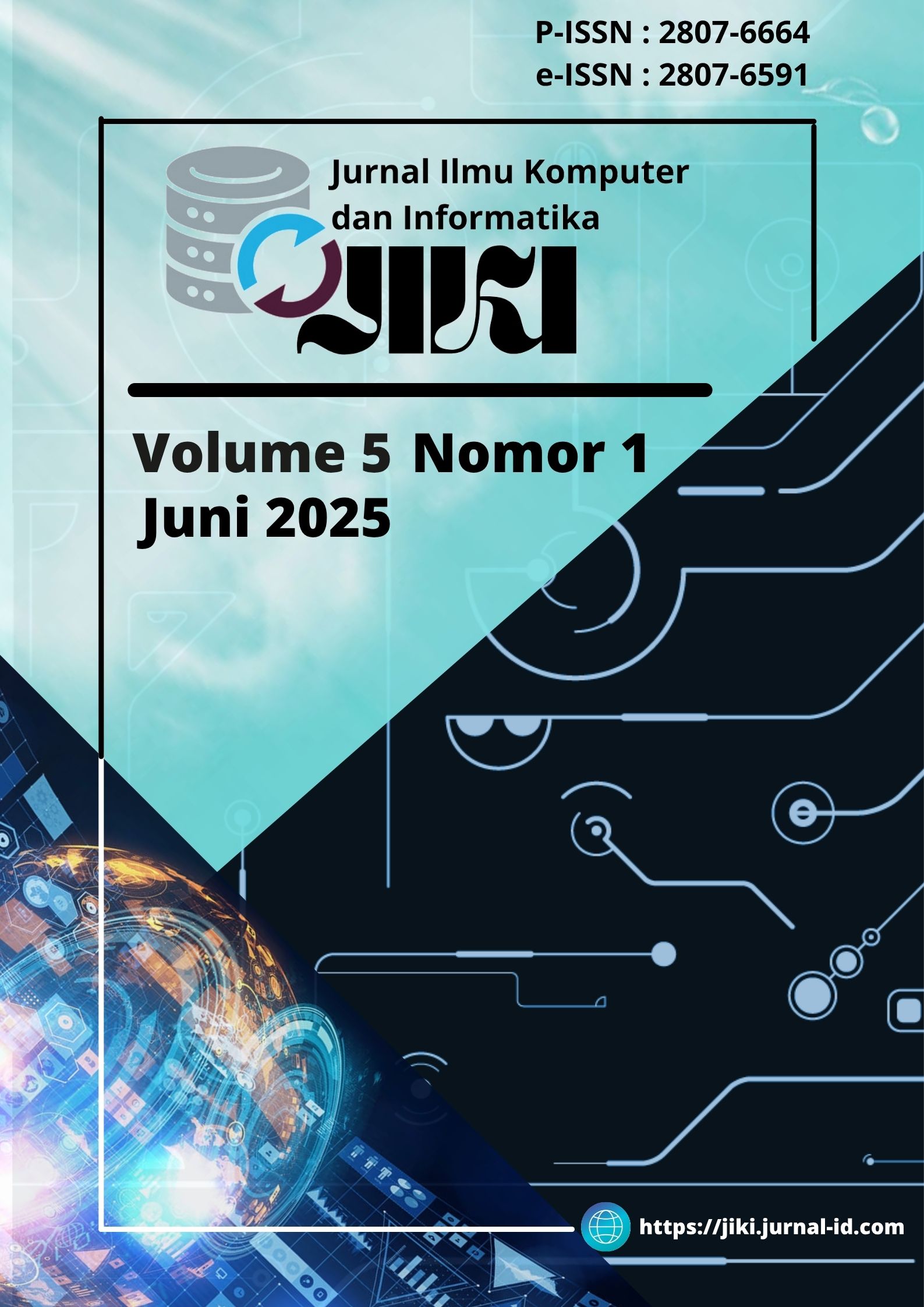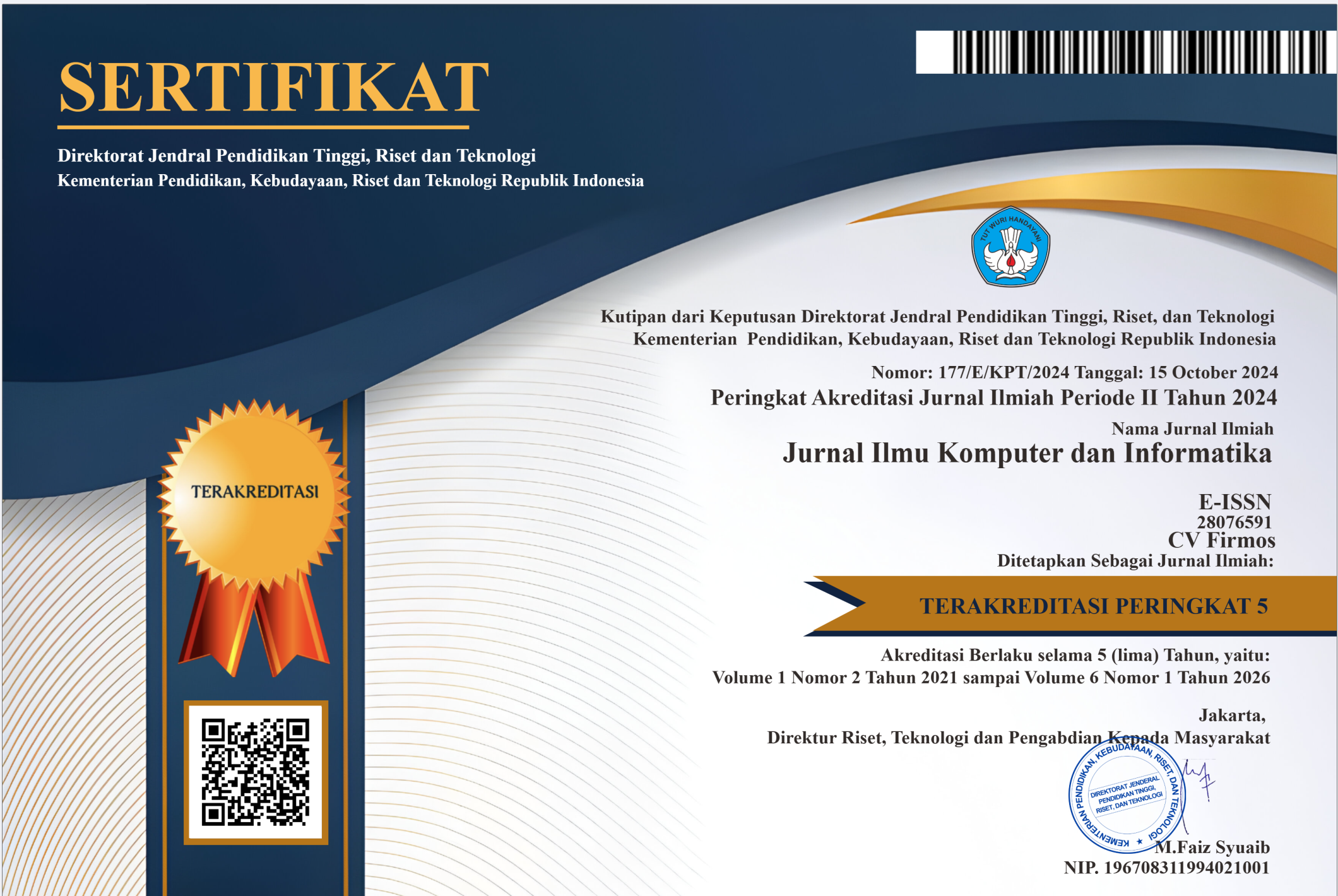Evaluation of Transfer Learning-Based Convolutional Neural Networks (InceptionV3 and MobileNetV2) for Facial Skin-Type Classification
DOI:
https://doi.org/10.54082/jiki.264Kata Kunci:
Convolutional Neural Network, Facial Skin Type, InceptionV3, MobileNetV2, Transfer LearningAbstrak
Manual classification of facial skin types often suffers from subjectivity and inconsistency due to reliance on human expertise. Accurate identification of skin types is crucial for selecting appropriate skincare solutions. This study evaluates the performance of two transfer-learning-based Convolutional Neural Networks (CNNs), InceptionV3 and MobileNetV2, for classifying facial skin types into four categories: normal, oily, dry, and acne-prone. A total of 1,733 facial images were collected from Kaggle and Roboflow and split into training, validation, and testing sets with a 70:20:10 ratio. Preprocessing involved normalization, augmentation, and resizing based on each model’s input size. Both models were fine-tuned and evaluated using accuracy, precision, recall, and F1-score metrics. InceptionV3 achieved the highest accuracy of 90.12% and a macro F1-score of 89.47%, particularly excelling in identifying normal and acne-prone skin. MobileNetV2 reached 81.15% accuracy and performed well on dry skin types. Confusion matrices and evaluation on new, unseen data confirmed the models’ generalization capabilities, though misclassifications still occurred among visually similar classes. These findings suggest that CNNs with transfer learning provide a robust foundation for developing AI-assisted facial skin-type classification systems, offering potential integration into dermatological applications.
Referensi
R. Oliveira, J. Ferreira, L. F. Azevedo, and I. F. Almeida, “An Overview of Methods to Characterize Skin Type: Focus on Visual Rating Scales and Self-Report Instruments,” Cosmetics, vol. 10, no. 1, pp. 1–15, 2023.
F. Bernerd, T. Passeron, I. Castiel, and C. Marionnet, “The Damaging Effects of Long UVA (UVA1) Rays: A Major Challenge to Preserve Skin Health and Integrity,” Int. J. Mol. Sci., vol. 23, no. 15, pp. 1–33, 2022.
F. B. KARA, R. KARA, and S. SAKACI ÇELİK, “Skin Type Detection with Deep Learning: A Comparative Analysis,” Düzce Üniversitesi Bilim ve Teknol. Derg., vol. 11, no. 2, pp. 729–742, 2023.
A. H. Abdulaal et al., “Cutting-Edge CNN Approaches for Breast Histopathological Classification : The Impact of Spatial Attention Mechanisms CUTTING-EDGE CNN APPROACHES FOR BREAST HISTOPATHOLOGICAL CLASSIFICATION : THE IMPACT OF SPATIAL ATTENTION MECHANISMS,” no. October, 2024.
H. E. Kim, A. Cosa-Linan, N. Santhanam, M. Jannesari, M. E. Maros, and T. Ganslandt, “Transfer learning for medical image classification: a literature review,” BMC Med. Imaging, vol. 22, no. 1, pp. 1–13, 2022.
X. Liu, G. Karagoz, and N. Meratnia, “Analyzing the Impact of Data Augmentation on the Explainability of Deep Learning-Based Medical Image Classification,” Mach. Learn. Knowl. Extr., vol. 7, no. 1, pp. 1–28, 2025.
J. Sadaiyandi, P. Arumugam, A. K. Sangaiah, and C. Zhang, “Stratified Sampling-Based Deep Learning Approach to Increase Prediction Accuracy of Unbalanced Dataset,” Electron., vol. 12, no. 21, pp. 1–16, 2023.
K. Vinay, V. Surya, S. Thushar, T. Singh, and A. Sahay, “A Deep Learning Framework for Early Detection and Diagnosis of A Deep Learning Framework for Early Detection and Diagnosis of Plant a Plant Diseases,” Procedia Comput. Sci., vol. 258, pp. 1435–1445, 2025.
Y. M. Alsakar, N. Elazab, N. Nader, W. Mohamed, M. Ezzat, and M. Elmogy, “Multi-label dental disorder diagnosis based on MobileNetV2 and swin transformer using bagging ensemble classifier,” Sci. Rep., vol. 14, no. 1, pp. 1–23, 2024.
J. Rashid et al., “Skin Cancer Disease Detection using Transfer Learning Technique,” Appl. Sci., vol. 12, no. 11, 2022.
X. Li et al., “A Migration Learning Method Based on Adaptive Batch Normalization Improved Rotating Machinery Fault Diagnosis,” Sustain., vol. 15, no. 10, 2023.
V. L. Helen Josephine, A. P. Nirmala, and V. L. Alluri, “Impact of Hidden Dense Layers in Convolutional Neural Network to enhance Performance of Classification Model,” IOP Conf. Ser. Mater. Sci. Eng., vol. 1131, no. 1, p. 012007, 2021.
I. Salehin and D. K. Kang, “A Review on Dropout Regularization Approaches for Deep Neural Networks within the Scholarly Domain,” Electron., vol. 12, no. 14, 2023.
I. B. Santoso, S. N. Utama, and Supriyono, “Meta-learning based softmax average of convolutional neural networks using multi-layer perceptron for brain tumour classification,” Array, vol. 26, no. December 2024, p. 100398, 2025.
S. Sathyanarayanan and B. R. Tantri, “Confusion Matrix-Based Performance Evaluation Metrics,” no. November, 2024.
Unduhan
Diterbitkan
Cara Mengutip
Terbitan
Bagian
Lisensi
Hak Cipta (c) 2025 Naufal Hafizh Muttaqin, Agung Mulyo Widodo

Artikel ini berlisensi Creative Commons Attribution 4.0 International License.


















